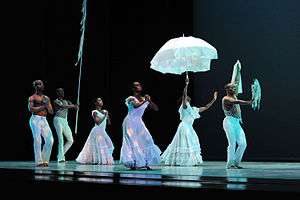Revelations (Alvin Ailey)

Revelations is the signature choreographic work of Alvin Ailey American Dance Theater. It was first produced by Alvin Ailey Dance Theater in New York City, New York on January 31, 1960. Revelations tells the story of African-American faith and tenacity from slavery to freedom through a suite of dances set to spirituals and blues music.
Overview
Ailey intended for the dance to be the second part of a larger, evening-length survey of African-American music which had been begun in 1958 with his work Blues Suite though this was never fully realized. At its premiere, the piece initially had 10 sections, a live vocal chorus, and was an over an hour in duration, and included 2 soloists. Sections were removed as the work evolved, and an extensive tour sponsored by the U.S. Department in 1962 forced Ailey to commit the music for Revelations to recording. The dance then solidified into the three-part format seen today with a duration of 38 minutes. The original score included parts for guitar, percussion and violin and voice. The piece was expanded to include parts for keyboards, drums and electric bass.
Ailey did not dance in the world premiere, but as early company personnel shifted, he performed some of its group sections as solos.
Revelations is divided into three sections "Pilgrim of Sorrow", "Take Me to the Water" and "Move, Members, Move"
Take Me to the Water
The second section features an enactment of a ceremonial baptism. A large group of dancers clad in white sweep onto the stage as baptismal agents—a tree branch to sweep the earth and a white cloth to cleanse the sky—lead a processional to the stream of purification. To the strains of "Wade in the Water" a devotional leader bearing a large umbrella baptizes a young couple at a river, represented by yards of billowing blue silk stretched across the stage. A raucous ceremony is followed by the meditative solo "I Wanna Be Ready", which communicates a devout man's preparations for death. Created by Ailey in collaborations with its original dancer James Truitte, the solo builds on exercises derived from the Horton modern dance technique.
Move Members, Move
The final section celebrates the liberating power of 20th-century gospel music. This section includes the propulsive men's trio "Sinner Man" and the famous "Yellow" section, set in a southern Baptist rural church. Eighteen dancers in yellow costumes enact a church service with fans and stools. Stretched across the stage with torsos proudly lifted, the dancers embody the joy of faith contained by complex stepping patterns performed in unison.
Original dancers
Joan Derby, Merle Derby, Jay Fletcher, Loretta Abbott, Gene Hobgood, Natheniel Horne, Herman Howell, Minnie Marsall, Nancy Redi, Corene Richardson, Don Martin, and Myrna White, James Truitte, Thelma Hill, Ella Thompson.